![]()
![]()
![]()
Use LEFT and RIGHT arrow keys to navigate between flashcards;
Use UP and DOWN arrow keys to flip the card;
H to show hint;
A reads text to speech;
45 Cards in this Set
- Front
- Back
|
How would one study adaptation? |
1. Experiments 2. Observational studies 3. Comparative studies |
|
|
What was learned in the experiment assessing the putative adaptations of jumping spiders nad tephritid flies |
Both marked wings and wing waving are essential to mimic the jumping spiders which deters jumping spiders. |
|
|
What are the components of a good experimental design |
1. Define and test effective control groups 2. All the treatments must be handled alike 3. Randomize 4. Repeat |
|
|
What was learned in the experiment assessing the putative adaptations of garter snakes |
Garter snakes make adaptive choices by choosing medium rocks for nighttime retreat more frequently than at random. Thus, snakes are active behavioral thermoregulators |
|
|
What was the hypothesis and the prediction to explain why some fruit bats have bigger testes than others. Was this correct? |
Hypothesis: Bigger testes is an adaptation for sperm competition
Prediction: Bats roosting in large groups will have bigger testes When group size was plotted relative to testes size there appeared to be a correlation between group size and testes size. However, this was actually due to the close relationship in their history and not a correlation. The small testes sized evolved separately but not independently so rather than having one group, you actually have pylogenetically dependent groups. |
|
|
What difficulties were posed when determining if the large testes found in large groups of bats were due to sperm competition? |
Because we're talking about a single species it was difficult to discern if large grouping evolved or if large testes evolved, or small testes or small groups. By grouping them on a phylogenetic tree we were able to see that what we thought was 6 data points were actually 2 datapoints. Thus the 6 datapoint swere phylogenetically nonindependent and the 2 datapoints were phylogenetically dependent and so this made for a poor correlation to group size and testes size. |
|
|
How was phylogenetic nonindependence handled? |
Through the use of Phylogenetic Independent Contrast |
|
|
When should the phylogenetic independent contrast method use |
To correct phylogenetic relatedness |
|
|
T/F: Based on the experiment performed on the bats and large testes, we could not reject that bigger testes is an adaptation for sperm competition |
True |
|
|
T/F: Daphnia uses phenotypic plasticity |
True |
|
|
In what situation do Daphnia respond phenotypically? |
To predation |
|
|
What type of response do Daphnia have when encountering fish |
Visual response |
|
|
What type of response do Daphni have when encounterin Copepod |
Morphological response |
|
|
What do Daphnia in the absence of predators
|
They move towards the surface |
|
|
T/F: The phenotypes displayed by Daphnia in the presence of predatorys are due to phenotypic platicity |
True |
|
|
Define: Monoecious |
When one plant contains both male and female parts |
|
|
Begonia's are monoecious meaning that they have both male and female parts. The female parts look like the male parts in order get polinated by bees. Experimentally it was found that more bees visited large flowers. Since this is the case, than why aren't all of the female parts large in order to attract bees for pollination? |
There is a trade off between energy and size. If the plant was only going to make large female parts, than there would be a limit as to the number of female parts that could grow. |
|
|
What are the constraints faced by adaptation |
Adaptation is natural selection for certain traits that fit your environment. Thus the only constraints that adaptation faces is a lack of genetic variation |
|
|
Which of the folowing statements is NOT true about phenotypic plasticity? A. Plasticity does not lead to evolution B. Individuals change their phenotype in response to their environment C. Offsprings will inherit the phenotype exhibited by their parents D. Siblings will exhibit different phenotypes if each is raised in a different environment E. Plasticity is facilitated by differences in gene expression |
C. Offsprings will inherit the phenotype exhibited by their parents. |
|
|
In comparative studies, it is important to be aware of phylogenetic relationships among species because: A. A trait that appear in several closely related species is probably an adaptation B. Two related species might have derived their trait from a shared ancestor, rather than each having evolved it independently C. Experimental conclusions are statistically more powerful when data points are NOT independent of each other. D. It is not necessary to have large sample sizes if the species are closely related |
B. Two related species might have derived their trait from a shared ancestor, rather than each having evolved it independently |
|
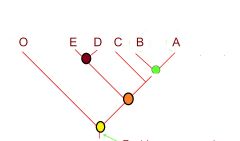
Using the Image which best describes sister taxa? A. A and B B. B and C C. C and D D. O |
A. A and B |
|
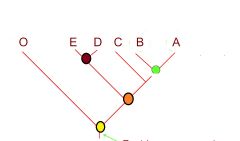
What is the closest common ancestor to E and D? A. Green dot B. Red Dot C. Orange Dot D. Yellow Dot |
B. Red Dot |
|
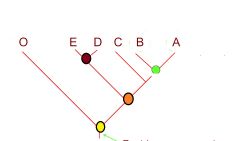
Which of the following represents the root? A. Green Dot B. Red Dot C. Orange Dot D. Yellow Dot |
D. Yellow Dot |
|
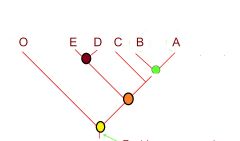
What taxa can be state to have branched from the Orange dot? |
A, B, C, D, E |
|
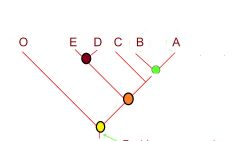
Taxa O is called |
An outgroup |
|
|
Define: Phylogeny |
The study of evolutionary relatedness among organisms |
|
|
Define: PHylogenetic tree |
Graphical summary of evolutionary relatedness among organisms |
|
|
Define: Phylogenetics |
The field of biology studying phylogenies |
|
|
Define: Phylogeneticist |
Biologist studying phylogenies |
|
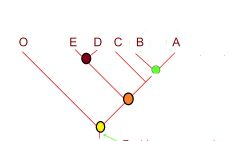
Which of the following is more closely related to C? A. A and B B. E and D C. E, D, and O D. O |
A. A and B |
|
|
T/F: The closest relative to a particular taxon is a taxon with which it shares the most recent common ancestor
|
True |
|
|
Define: Polytomy |
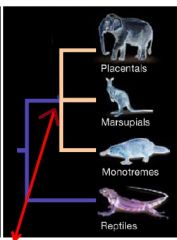
When you have more than one descendants at a common ancestor |
|
|
How does a polytomy form |
When there is more than 2 descendants from a common ancestor because the split happened so fast that we don't know which split first |
|

Which is more closely related? A. 4 and 5 B. 5 and 7 |
B. 5 and 7 |
|
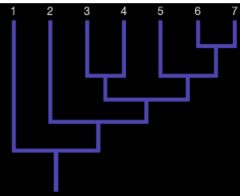
Which is more closely related? A. 1 and 2 B. 2 and 7 |
B. 2 and 7 |
|

Which is more closely related? A. 3 and 4 B. 2 and 4 |
A. 3 and 4 |
|
|
T/F: Different topographis are interchangeable |
True |
|
|
Define: Monophyletic group |
Includes all descendant taxa and their common ancestor |
|
|
Which of the following is the only natural taxon? A. Monophyletic group B. Polyphyletic group C. Paraphyletic group |
A. Monophyletic group |
|
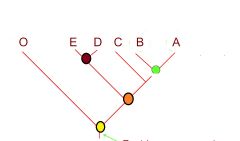
Which of the following would make up a monophyletic group? A. A and C B. D, C, B C. E and D D. E and A |
C. E and D |
|

Which of the following would make up a polyphyletic group? A. A and C B. E, D, C C. E and D D. E and A |
B. E, D, C |
|
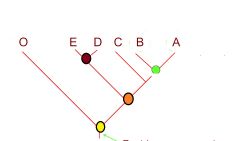
Which of the following would make up a paraphyletic group? A. A and C B. E, D, C C. A, B, C, D D. O |
C. A, B, C, D |
|
|
Define Polyphyletic group |
Consisting of two clade groups |
|
|
Define Paraphyletic group |
Consisting of a monophyletic group missing one clade |
|
|
T/F: Reptiles are Paraphyletic if birds are not included |
True |

